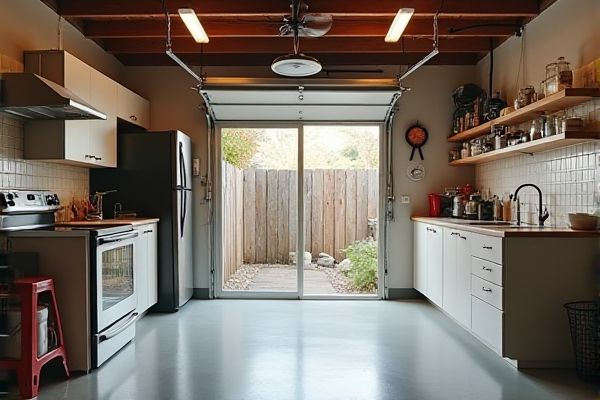
Appliance garages conceal small kitchen appliances, keeping Your countertops clutter-free and enhancing a sleek, organized appearance, while open countertop storage offers easy access and displays frequently used items for quick convenience. Discover which storage solution best suits Your kitchen style and functionality needs by exploring the full comparison in this article.
Table of Comparison
| Feature | Appliance Garage | Open Countertop Storage |
|---|---|---|
| Design | Enclosed cabinet with roll-up or hinged doors | Exposed shelves or countertop space |
| Visibility | Hidden appliances for a cleaner look | Appliances and items fully visible |
| Counter Clutter | Minimizes clutter on countertops | Tends to increase visible clutter |
| Accessibility | May require door operation to access appliances | Easy, direct access |
| Protection | Protects appliances from dust and grease | Appliances exposed to dust and splatters |
| Cost | Generally higher due to cabinetry and hardware | Lower cost, depends on shelving choice |
| Customization | Highly customizable to fit appliances | Limited to shelf size and layout |
| Maintenance | Requires cleaning inside garage and doors | Requires frequent countertop cleaning |
Introduction to Appliance Garage and Open Countertop Storage
Appliance garages offer a concealed storage solution designed to keep small kitchen appliances like toasters and mixers out of sight, reducing countertop clutter and maintaining a sleek kitchen aesthetic. Open countertop storage provides easy access to frequently used gadgets and tools, promoting convenience and efficient workflow during meal preparation. Both storage options optimize kitchen organization by addressing different needs for accessibility and visual appeal.
Definition and Features of Appliance Garage
An appliance garage is a built-in cabinet designed to store small kitchen appliances like toasters and blenders, keeping them hidden yet easily accessible. It typically features a roll-up or tambour door that retracts to save space and maintain a clean countertop aesthetic. Your kitchen benefits from reduced clutter and enhanced organization by integrating an appliance garage for streamlined storage.
Definition and Features of Open Countertop Storage
Open countertop storage refers to kitchen organization solutions where appliances and frequently used items are placed directly on the countertop without enclosures, offering immediate accessibility and visibility. This setup features uninterrupted workspace, easy cleaning, and the ability to quickly grab your appliances, but may lead to a cluttered look if not managed carefully. Compared to appliance garages, open countertop storage lacks protective covers but enhances convenience and display options for modern kitchens.
Aesthetic Impact on Kitchen Design
Appliance garages create a streamlined, clutter-free kitchen appearance by concealing small appliances, enhancing a modern and minimalist aesthetic. Open countertop storage offers easy access to frequently used items, contributing to a more casual and personalized kitchen atmosphere. Choosing between the two depends on the desired balance between sleek design and functional display.
Space Efficiency and Organization
Appliance garages maximize kitchen space by concealing small appliances, reducing countertop clutter and creating a streamlined, organized look. Open countertop storage offers quick accessibility but often sacrifices tidiness, making it harder to maintain an efficient workspace. Choosing an appliance garage enhances space efficiency by keeping items hidden yet within reach, promoting both cleanliness and functionality.
Accessibility and Daily Convenience
Appliance garages offer concealed storage that keeps your countertop clutter-free while allowing quick access to frequently used appliances, enhancing daily convenience. Open countertop storage provides immediate visibility and reach, ideal for users who prioritize speed and ease of access during cooking. Your choice depends on whether you value a streamlined, tidy kitchen or the convenience of having all appliances readily available.
Maintenance and Cleaning Considerations
Appliance garages offer easier maintenance by concealing appliances, reducing dust accumulation on countertops and simplifying surface cleaning. Open countertop storage requires frequent wiping to prevent dust and grease buildup on exposed appliances and surfaces. Sealed appliance garages also protect cords and outlets from dirt, enhancing overall kitchen hygiene and minimizing cleaning frequency.
Cost Comparison: Investment and Installation
Appliance garages typically require a higher initial investment due to custom cabinetry and complex installation, often costing between $500 to $1,500 depending on materials and design. Open countertop storage offers a more budget-friendly option with costs ranging from $100 to $400 for simple shelves or racks, and requires minimal installation time. Your choice should balance upfront costs with long-term convenience, as appliance garages protect devices but involve greater expense and labor.
Suitability for Different Kitchen Styles
Appliance garages offer a sleek, concealed storage solution ideal for modern, minimalist, or traditional kitchens seeking a clutter-free countertop appearance. Open countertop storage complements farmhouse, industrial, or rustic kitchens by showcasing frequently used appliances while adding to the overall decor. Choosing between the two depends on the desired aesthetic, with appliance garages emphasizing clean lines and open storage enhancing accessibility and visual interest.
Which Storage Solution Is Best for You?
Appliance garages provide a sleek, clutter-free kitchen by concealing small appliances, ideal for those who prefer a minimalist look and easy access to devices without sacrificing counter space. Open countertop storage offers convenience and quick reach for frequently used items, perfect for busy cooks who prioritize functionality and visibility over aesthetics. Your choice depends on whether you value a tidy, organized kitchen or immediate accessibility to your appliances during meal preparation.
 homyna.com
homyna.com